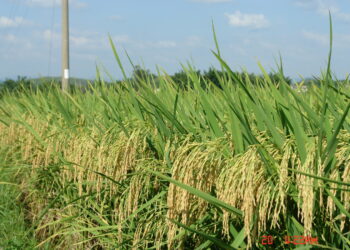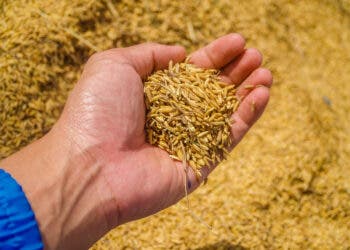Looking at the unsuspecting rice plants grown in Switzerland and Taiwan, you wouldn’t think too much of them. But rice magic happens on the inside. The plants have been fortified in vitamin B1 (also called thiamine), an essential micronutrient that plays a crucial role in maintaining healthy metabolic processes and energy levels in humans.
Biofortification is the process of enhancing the nutritional value of crops through genetic modification or agronomic practices to increase the concentration of essential nutrients. Essentially, it increases the nutrient content of the rice during its growth phase. In this case, when the rice is consumed, it helps to combat malnutrition and vitamin B1 deficiencies that are common in many parts of the world.
This is far from the only type of fortified rice. Researchers around the globe are exploring various ways to enhance rice with essential vitamins and minerals — but will people accept them?

B1 rice
Around half the world’s population relies on rice for most of their meals. But although rice is a rich source of carbohydrates, you can’t build a healthy diet only on rice.
Most vitamins come from the food we eat, and for populations that rely on a single type of food, it’s difficult to meet these nutritional needs. There is no official estimate for global deficiency in vitamin B1 but thiamine deficiency is more common in areas with high rates of poverty. So researchers at the University of Geneva and ETH Zurich worked on a way to fortify rice with vitamin B1.
Previous efforts to biofortify rice with thiamine had limited success. Unfortunately, these enhancements were lost once the rice was polished. The team’s breakthrough lies in overcoming this barrier, ensuring that the increased thiamine levels persist in the final product.
The research, led by Dr. Teresa Fitzpatrick and Prof. Wilhelm Gruissem, introduced a gene from sesame known for binding thiamine into the rice genome. This gene, expressed specifically in the rice endosperm — the part retained in polished rice — significantly boosted the thiamine content without affecting the plant’s growth or yield.
‘‘Previous attempts at biofortification by other teams had succeeded in increasing the vitamin B1 content of the leaves and bran — the outer layer of rice grains — but not that of the ready-to-eat rice grain. In our study, we specifically targeted the increase in vitamin B1 content in the endosperm,’’ explains Teresa Fitzpatrick, first author of the new study, in a media release.
The next phase for the researchers involves incorporating this trait into locally preferred rice varieties to ensure cultural and culinary suitability. Additionally, the team plans to explore synergistic genetic modifications that could further enhance the thiamine content or improve the plant’s uptake of this essential nutrient.
Pink “meat” rice

Meanwhile, researchers at Yonsei University in South Korea had a different idea. They’ve created a hybrid, pink rice by integrating animal cells into rice grains.
The approach is similar to that used in cultured meat. The rice grains were coated in fish gelatin to keep the beef cells in the rice. These grains were then incubated and later cooked, resulting in a product that not only boosts protein content but also maintains a taste profile not too far from regular rice. The flavor is described as reminiscent of butter and almonds with a faint fatty aftertaste, making it a palatable option for those accustomed to conventional rice.
Every 100 grams of rice typically has around 3 grams of protein, with some types having up to 7 grams. This new rice isn’t a massive change, but it’s a significant one, containing around 10% more protein. Again, this is targeted at people whose diets consist mostly of rice.
This development is part of the broader field of cultured meat, which involves growing meat from animal cells. This technique is seen as a potential solution to the environmental, ethical, and health issues posed by traditional meat production. Cultured meat requires fewer resources, reduces the need for livestock, and can be engineered to be free from antibiotics, significantly lowering the risk of antimicrobial resistance.
This hybrid rice is also quite sustainable to grow, and marks a shift in the already established approach of “culturing” meat. It represents a significant innovation in using existing agricultural products as scaffolds for cultivating meat, potentially revolutionizing the way we think about and consume staple foods. Moreover, the technology could be particularly valuable in emergency relief situations or in regions with limited food resources.
Golden Rice is deemed safe in some countries

Golden Rice stands as probably the most established type of fortified rice, designed to combat vitamin A deficiency. Every year, around 500,000 children go blind due to a lack of vitamin A. So, this is a severe public health issue. This genetically modified rice produces beta-carotene in the grain. The body can convert this into vitamin A, offering a potential dietary supplement to prevent the devastating effects of this deficiency.
Golden Rice is engineered by inserting genes from a daffodil and a common soil bacterium into rice. These enable the plants to produce beta-carotene in the endosperm, the edible part of the rice.
Initially developed in the late 1990s by Dr. Ingo Potrykus of the Swiss Federal Institute of Technology and Dr. Peter Beyer of the University of Freiburg, Golden Rice was created to help those in low-income countries who suffer from a lack of dietary vitamin A. What sets Golden Rice apart from its conventional counterpart is its golden color due to the presence of beta-carotene.
In 2018, the U.S. Food and Drug Administration (FDA) acknowledged that Golden Rice is safe to eat. Canada and New Zealand quickly followed suit. But a more critical decision happened in the Philippines. The Philippines granted approval for not just consumption but cultivation of Golden Rice in 2021. This makes it the first country to allow the commercial propagation of this genetically modified crop.
However, things took a turn two weeks ago. In April 2024, the Court of Appeals in the Philippines ordered a halt to the commercial cultivation Golden Rice, citing concerns over the absence of complete scientific certainty about their potential health and environmental risks — despite support from leading scientists.
Which begs the question: will people actually prefer these types of fortified rice?
The classic GMO conondrum
While researchers continue pushing the boundaries of agricultural science to fortify rice with essential nutrients, the true test lies in consumer acceptance and regulatory approval. The future of these innovative rice varieties depends heavily on public perception and the scientific community’s ability to effectively communicate their benefits and safety.
This is not a simple challenge. Public skepticism around genetically modified organisms (GMOs) is high in most regions. This hesitancy is compounded by cultural and regional food preferences that might resist unconventional staples like pink “meat” rice or even the visually distinct Golden Rice. Despite proven health benefits and safety, people are often skeptical of this type of food.
As seen with Golden Rice in the Philippines, even after gaining approval, GM crops can face legal and social hurdles. Often, these delay or entirely cancel their introduction to the market. So, while fortified rice varieties offer promising solutions to global nutritional deficiencies, their success will ultimately depend on overcoming social, not scientific challenges.
The rice of the future may be fortified with protein and vitamins; or it just may be plain old rice. The jury is still out on this one.






